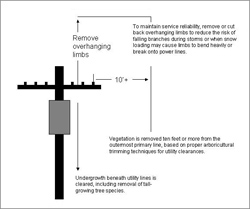How We Trim
A team of experienced foremen/foresters from Central Hudson oversees the vegetation management program throughout the Mid-Hudson Valley, and work is performed by qualified tree service contractors. These contractors follow Central Hudson and industry standards and regulations, including those of the International Society of Arboriculture (ISA), American National Standards Institute (ANSI) and Occupational Safety and Health Administrations (OSHA).
Tree crews use a technique called “directional pruning,” which means cutting branches where they join another branch or at the trunk of the tree. This technique lessens or eliminates the number of unsightly stubs and maintains a more natural appearance for the trees. This method also reduces the chances for trees to develop disease, fungus or insect infestation.
Central Hudson performs line clearance on both the Distribution and Transmission systems.
Distribution Lines
Routine distribution line clearance addresses power lines that primarily run along local roadways to provide electric service to homes and businesses. Branches and limbs that may endanger electric lines are cleared to gain 10 feet of side clearance; to remove or cut back overhanging limbs; and to remove from beneath the line all undergrowth of tall growing tree species. Removal of overhanging limbs, branches and leaders from above electric lines is critical to maintaining and improving system reliability and safety. This is especially important for those branches or limbs that may contact lines under snow and ice load, as they are the leading cause of outages.
Tall growing tree species located beneath or directly adjacent to our line (within the utility Right-of-Way (ROW) with the exception of yard trees, are removed as they pose a risk to electric safety and reliability. Trees located outside of the utility ROW which may be dead, dying or are leaning heavily towards the electric lines are considered danger trees and will be removed with permission from the property owner. Notification letters are sent to customers in advance of performing line clearance along the circuit.
Transmission Lines
Vegetation management for transmission corridors addresses the nearly 600 miles of lines that deliver bulk power to the region. Transmission lines are typically located off-road, and are built on easements generally 100 feet in width. Central Hudson’s Long Range Vegetation Management Plan, which is submitted, reviewed and approved by the New York State Public Service Commission, outlines how the transmission corridors will be maintained.
New state and federal standards for clearing and maintaining transmission corridors were enacted following the 2003 blackout that affected much of the northeastern United States. The New York State Public Service Commission has required by regulation that all electric utilities in New York must maintain their transmission right of ways as follows:
- Remove all non-compatible, tall growing tree species within the easements
- Identify and remove any hazardous or “danger” tree that could contact lines
- Control tall growing vegetation on maintenance cycles to ensure the integrity of the easement through mowing, clearing and utilization of authorized herbicides
- Maintain clear easements to their full width or limits.
All non-compatible trees within the full width of transmission easements are removed and cleared on a routine basis. Dangerous trees outside of the easements are also removed, with permission from property owners (where applicable). Selective use of EPA/NYSDEC approved herbicides, which are applied by low volume techniques using hand operated backpack equipment, ensures minimal herbicide usage to control tree growth within the easements. Property owners are notified by Central Hudson employees or authorized contractors prior to the application of herbicides, according to NYS DEC herbicide regulations. Central Hudson’s program encourages the growth of natural low-growing vegetation to prevent soil erosion and to provide a more natural habitat for meadowland birds and animals.
Notification letters are sent to property owners in advance of transmission row management activities.
Central Hudson's vegetation management program utilizes an Integrated Vegetation Management (IVM) approach, which is a practice endorsed by the U.S. EPA. Click these links to read more about IVM and IVM on Rights-of-Way.
Service Wires
Service wires supply electricity from Central Hudson utility poles on local streets or roadways to homes and businesses. These lines are not cleared by Central Hudson, but can be by a contractor hired by the home or business owner. For a fee, Central Hudson crews will disconnect the line so that the contractor can safely clear or remove trees, and will reconnect the line when the work is completed.
Tree Clearance During Storms
Central Hudson crews and contractors will perform necessary line clearing to facilitate electric service restoration. As storms are an act of nature, and due to the necessity to expedite repairs, Central Hudson does not chip or remove branches, logs or brush during storm restoration. Property owners may contact their municipality to have the brush or wood removed.
For questions related to distribution or transmission line clearance, you may contact us through the link below.
Contact Form: Tree-Related Topics



